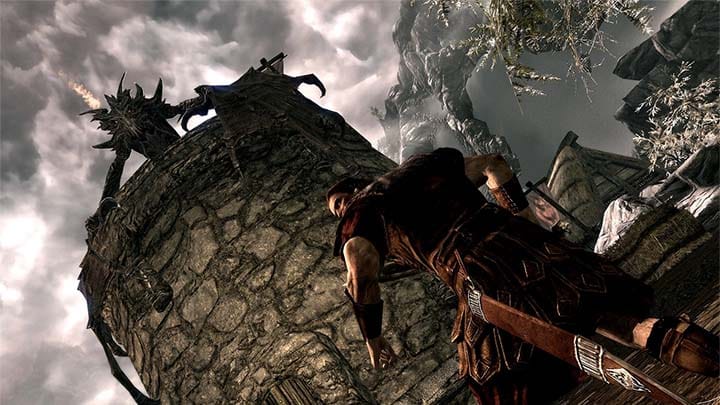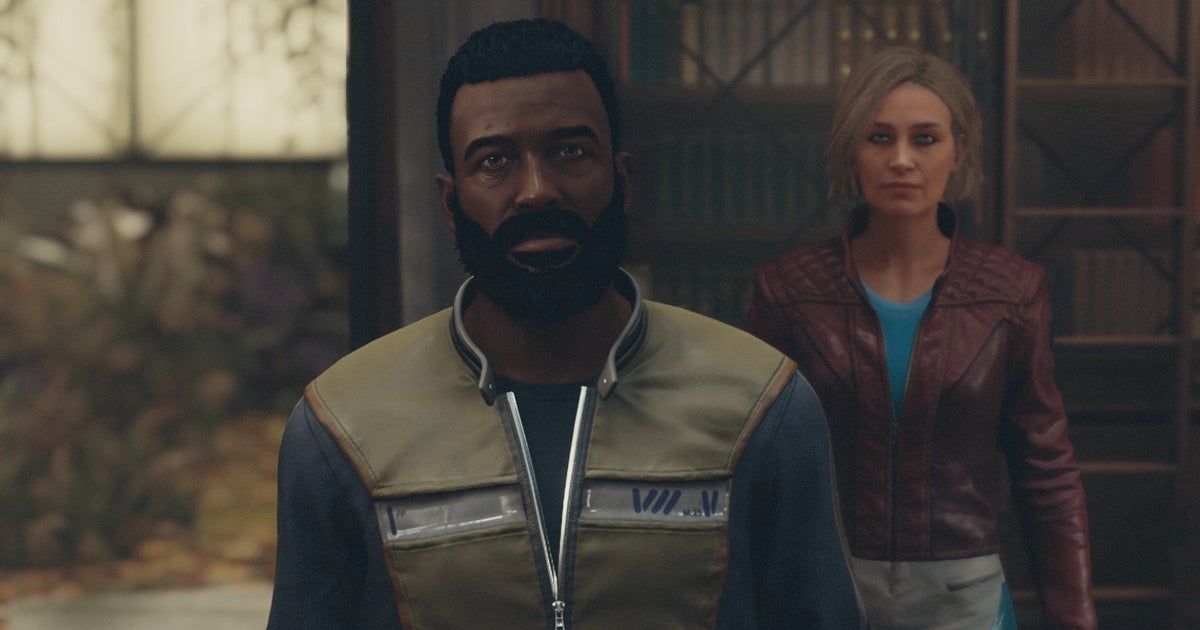The Elder Scrolls VI Needs To Learn From Starfield
Starfield highlights Bethesda having lost the plot in a way that has fans worried about what that might mean for The Elder Scrolls VI.
Climbing the wooden stairs to emerge from below deck and getting my first look at Vvardenfell is a core gaming memory of mine, and I’m sure many other gamers of my vintage. Seyda Neen’s peaceful, middle-of-nowhere village vibe is only pierced by the game abruptly informing you you’re on your own upon leaving the Census and Excise Office, and perhaps by a disgruntled villager displeased with an Outlander wasting their time. Crossing the bridge to leave the town brings all the excitement and thrill of a newborn adventure, as well as all the uncertainty of the unknown as you take your first steps into what is a familiar yet alien landscape.
Bethesda would continue to invest heavily in the opening moments of their games which can be seen in Oblivion’s sewer exit into the Tolkien-esque Cyrodiil after witnessing the assassination of the Emperor, Skyrim’s trek down the mountain after the Dragon attack on Helgen, or even the rush to get your family to safety before the beginning of the end of it all in Fallout 4. These moments serve to anchor the player in the world they’re about to participate in and garners investment from them even before their journey truly begins.
Contrast these openings with your introduction into the world of Starfield, and it becomes apparent that Bethesda may have forgotten what helped make their previous games great – or at the very least what helped them overcome their faults. Sadly, this extends beyond just the introductory hours of the game. This isn’t meant to be a re-hash of my review of Starfield of course, but Starfield highlights Bethesda having lost the plot in a way that has myself and many other fans of their games worried about what that might mean for The Elder Scrolls VI.
Starfield doesn’t just skirt the time-worn formula of its predecessors, it does a 180 and awkwardly jetpack boosts in the opposite direction. Clocking in for your first shift at a space rock mining operation and listening to your supervisor say hi to every subordinate along the way before you’re drafted to be the poor sod who gets to investigate the shiny rock thing that was just unearthed is a painfully meandering start that never gets off the ground.
Look, Bethesda games have never been perfect and a lot of their critical acclaim and commercial success has historically hinged on few developers attempting to enter their space, and the strength of their open worlds overshadowing the fact that they are often bug-ridden messes even after a dozen patches. What made Bethesda games of old great is something I’m sure could be debated. Still, I believe that the most core aspect of Bethesda’s previous successes rests on two things specifically: world-building and environmental design. These two fundamentals helped make those opening segments and broader gameplay in Morrowind, Oblivion, and Skyrim so impactful regardless of how action-packed they were and in turn, what makes Starfield comparatively weak.

The overtly delivered stories in Bethesda games were rarely spectacular, and only a handful of characters ever stole the show, but that was ok because the world they occupied was a stage set for the player to experience and be a part of in such a way that it made it all seem far grander. Characters felt less like they existed to serve a plot point and more like they were an equal participant in the world at large with the player which lent itself to the player being able to get lost in it all. Morrowind, for example, did a fantastic job of avoiding making everything that the player experienced in the game feel like it was just there for the player – this bolstered by the well-navigated plot points that ensure you understand you aren’t just some untouchable messianic figure who walks on water (at least not without a spell or potion first). Starfield conversely makes everything feel like it’s there to give the player something to do, and with the exception of perhaps one plot point that is mostly subverted by itself anyway, doesn’t do anything to make the player feel otherwise. This makes much of the game feel more like a digital version of Willy’s Chocolate Experience than a universe to actively participate in.
That would perhaps be ok if Starfield held up from an exploration standpoint. After all, a huge reason many players fall in love with Bethesda games is because of the beautiful worlds to explore and discover. They’ve often been some of the best gaming examples of the journey being more important than the destination. Sadly, this too is where Starfield doesn’t just fall short but catastrophically misses the mark. Indeed, much of the more run of the mill aspects of Bethesda games past relied on wonderous sights and unexpected distractions getting from point A to point B. When you remove this trademark design philosophy without making the destination far more valuable, it doesn’t leave you with much to get excited about.
When Todd Howard was pitching Starfield in pre-release interviews and conferences, much emphasis was placed on the vast number of worlds you’d be able to not just explore but engage with. I remember watching the Lex Fridman podcast when he had Todd on and listening to Todd wax poetic about the complex procedural generation systems they had created to make all of these worlds a reality – all while vaguely talking down about No Man’s Sky without directly mentioning it by name. It certainly got my attention, in that I had always envisioned how a team with more money and manpower should elaborate upon No Man’s Sky’s systems, and how that could seriously change the face of gaming. Clearly, Bethesda didn’t accomplish this in Starfield as is evidenced by the vast empty worlds that make up the majority of Starfield’s universe – worlds we’re supposed to be excited about apparently because the people who actually walked on the moon weren’t bored with its lack of trees. As it turns out, taking the already-aged nature of Bethesda’s radiant quest system and spreading it wafer-thin across hundreds and thousands of empty worlds instead of a singular, beautifully hand-crafted and fully realized location is not a recipe for success.
Starfield losing out on these defining characteristics ends up tearing away the last of the remaining façade their games had as the industry caught up and passed them in a post-Skyrim world. It has no world-building, and no environmental design to facilitate a player getting lost in its universe, although you would be forgiven if you literally got lost given the lack of town maps or the universe’s worst star chart. The Witcher 3 is often cited as the watershed moment for the loss of Bethesda’s market segment dominance, and I believe that it also falls victim to Baldur’s Gate 3 – and not just because Starfield’s character animations look like they’re 15 years out of date. I was confident that Fallout 4 was the canary in the coal mine for Bethesda games, and it seems that was the case. At least Fallout 4 got timely post-launch content support – Starfield hasn’t received much more than some bug fixes and the ability to open doors while holding your scanner in the six months since release.

I think a decent barometer for a successful Bethesda game is the health of the modding community. The more invested the modding community is, the more likely the game has won the hearts of the community at large. Of course, it’s another discussion entirely as to whether or not Bethesda has come to lean too heavily upon the modding community to finish their games and provide much of the post-launch support they themselves should be doing, but its undeniable that games like Skyrim continue to be successful in no small part because of the modding community. Starfield’s modding community sadly hasn’t shown signs that it’s likely to be similar to that of Skyrim’s and instead, it looks like it will get more meagre support like that of Fallout 4. In fairness, as of this writing, Bethesda has yet to release the Creation Kit 2 set for Starfield which ties the hands of modders and keeps them from doing any major work. Perhaps when that is released things will pick up, but at least one prominent modding team has already stated that they have little interest in building anything for Starfield.
What then, should Bethesda do to make sure that The Elder Scrolls VI doesn’t repeat the same mistakes? I believe that the answer is self-evident, but it comes with added pressure. Clearly, Bethesda needs to remember what it’s always been best at and ensure that those competencies aren’t minimized or discarded altogether in The Elder Scrolls VI. Focus on making sure the world is large enough to feel alive, but not so large that hand-crafted environments become an impossibility that leads to soulless design. Craft a world that is full of characters and events that feel like they’d continue on even if the player character wasn’t there to conveniently save the day so that we’re a participant in a grander mechanism instead of being the mechanism that drives the characters and world. Invest in getting the player invested. Don’t assume that just because the world is there that players will automatically care.
Perhaps an equally important lesson to be learned from Starfield is that Bethesda has to make an effort to modernize nearly every aspect of their games going forward. So much in gaming has changed and improved since 2011, and it’s time that Bethesda stopped ignoring their lagging behind in this regard. Even if Starfield had the world-building and design philosophies of old which are more timeless elements, much of the rest of the game would still have felt like it was ripped out of 2014 and that is perhaps an equally damning reality that brings into question what Bethesda has in store for The Elder Scrolls VI. It’s perfectly understandable that when tackling games as large in scope as Bethesda traditionally has, processes and systems have to be repurposed over time to get more value out of the man-hours required to build those processes and systems to begin with. Eventually, though, you have to step out and give yourself a stronger foundation – you can’t just keep adding duct-taped stories onto your decades-old foundation and expect it to hold up forever.
As the saying goes, you should strike while the iron is hot. Bethesda’s iron has remained hot for longer than many developers could ever dream of, but it has been cooling post-Fallout 4. Bethesda is an enormous developer with access to as much funds as just about any other developer in the business, but in a world where studios can live and die on a single game not even they are safe forever. The Elder Scrolls VI is likely to be the most ambitious game Bethesda ever produced, and possibly Todd Howard’s swan song. When Morrowind was made, Todd mentioned that it was under the pressure of the company folding should it fail, and so everyone was all hands on deck and all-in to make it a success. Bethesda may not be in such dire straits today, but perhaps that’s the kind of mentality that will be needed to snap Bethesda out of its funk and help ensure The Elder Scrolls VI creates more core gaming memories for the generations to come.

